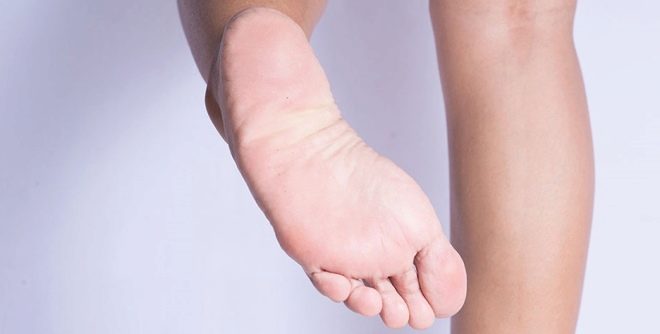Heel problems in children and adults in terms of psychosomatics
The heel is an important part of the foot. It serves as a support person, it is important for the process of walking, running. Therefore, even minor health problems of the heels cause considerable difficulties in movement in both children and adults. In this article we will talk about the psychosomatic causes of various disorders in the state of our heels.
What can happen?
The most common problem is cracks in the skin of the heels. They hurt, cause inconvenience and interfere with wearing shoes. Heels that crack, look ugly and can bleed. Upon accession of a secondary infection, inflammation of a bacterial or fungal nature is not excluded. The second fairly common cause of heel complaints is the heel spur. This disease is accompanied by excessive deposition of mineral salts on the calcaneus. Formed a painful protrusion, spike, which causes severe pain in the heel when walking.
Also complaints about the health of the heels can be in people with gout and rheumatoid arthritis, flat-footedness, viral or valgus curvature of the feet. Evidence-based medicine has several ways to alleviate the patient's condition: local and systemic anti-inflammatory drugs are used, some problems are resolved with the help of surgical intervention.
Psychosomatic causes
The method of psychoanalysis of diseases allows to identify other causes of pain in the heels. If evidence-based medicine is based on versions of metabolic disorders, overweight and wearing uncomfortable shoes, psychosomatic medicine considers some psychological and mental attitudes that also contribute to the development of "heel" ailments.
Psychosomatics regards the foot of a person as a point of support, self-reliance, ability and desire to move forward through life. Any violations of the condition of the heels may indicate that a person has problems with self-identification, self-esteem, as well as with goals and ways to achieve them. Cracks on the heels are often associated with insufficient purposefulness and great fear of mistakes on the chosen path. People who have doubts about themselves, who have low self-esteem, usually have this problem. They are often afraid to take the necessary step because of the fear of losing what they already have, for fear that the consequences of the act will be negative.
Painful heel spur often develops in very stubborn people with unshakable ideas about life. Anyone who tries to convince such a person risks running into stiff resistance. Being mistaken, such people blame not themselves, but others, for this, but do not reconsider their actions.
They often say about such people “they step on the same rake”. The appearance of the heel spur is always a signal that a person’s attitudes are erroneous, he needs to show a little more flexibility in relation to different points of view.
The spur on the right heel suggests that the person is too despotic towards others. His demands on people go beyond reasonable limits. The pain in the left heel due to the formation of salt deposits suggests that a person is too much pressure on their loved ones - children, spouse, parents. According to psychoanalysts, sometimes a spur develops in people who have too much guilt for some act that has harmed close people.
Then the spur acts as self-punishment, it makes every step at the physiological level a painful reminder that you need to calculate the consequences of your decisions and actions. Spurs can torment a person with excessive deposition of calcium salts, but this happens to a lesser extent on age or exchange factors, and more on the conscious refusal of a person to move in front of, develop, change his mind, gain new knowledge and skills.
Who is prone to ailments?
Before making a psychological portrait of people suffering from a spur or other abnormalities in the functioning of the calcaneus, psychosomatics analyze a large number of case histories of patients of different ages. As a result, a list of the most common coincidences is formed, which may indicate the causes of the development of problems. It has been revealed that the heel spur most often develops among those who in childhood were strictly forbidden to throw out emotions. “Do not shout,” “do not cry,” “do not be angry,” “keep quiet” - such parental attitudes are very firmly fixed by the child’s subconsciousness and in the future form the basis for the development of foot health problems.
Such people are quite tough, principled, and unable to show true feelings. Often they occupy leadership positions. Women often develop problems with their heels with a lifestyle borrowed from men - strong-willed, powerful, strong women are more likely to suffer from a spur or gout than are feminine, tender and not trying to compete in anything with men. Men with such a problem often have increased responsibility (professional or personal), and therefore do not allow themselves to relax, rarely rest.
Treatment
In order to get rid of heel problems, a person is recommended to stop over-taking care of loved ones, to take a heavy burden of responsibility, and you should also reconsider your attitude towards demanding. Not only moderate exercise and limiting salt intake are useful, but also moderate demands on others and reducing your own stress.
No need to stubbornly and refuse treatment, which offers evidence-based medicine. Only an integrated approach will eliminate the problem and forget about it forever. Experts in the field of psychotherapy recommend reducing emotional stress, reducing self-criticism and value judgments of others. If there are fears, it is better to consult a psychologist in order not only to find the cause, but also to correct it correctly.
In the future, you should not drive yourself into too rigid limits. This applies to all areas of life. Barring himself to enjoy life, a person provokes the aggravation of problems with heels.















